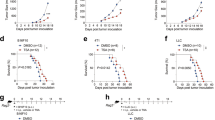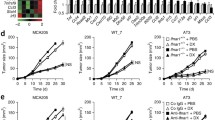Abstract
The anticancer drug taxol (paclitaxel) inhibits tumors through multiple cytotoxic and cytostatic mechanisms. Independently of these mechanisms, taxol induces distinct immunological efficacy when it acts as a second signal for activation of tumoricidal activity by interferon-γ(IFNγ)-primed murine normal host macrophages. We reported that tumor-distal macrophages, which mediate immunosuppression through dysregulated nitric oxide (NO) and tumor necrosis factor α (TNFα) production, are differentially regulated by taxol. Because taxol influences tumor cell growth dynamics and activates immune cell populations, we assessed the ex vivo immunosuppressive and antitumor activities of taxol-treated normal host and tumor-bearing host (TBH) macrophages. Pretreatment of such cells with taxol partly reconstituted T cell alloantigen reactivity, suggesting that taxol mediates a limited reversal of TBH macrophage immunosuppressive activity. Taxol-treated TBH macrophages significantly suppressed the growth of fibrosarcoma cells (Meth-KDE) through soluble effector molecules and promoted direct cell-mediated cytotoxicity, indicating that taxol enhanced tumor-induced macrophage antitumor activities. Tumor-induced helper T cells, however, showed a higher sensitivity to direct taxol-induced suppression. These data demonstrate that taxol exerts pleiotropic effects on antitumor immune responses with the capacity to abate the immunosuppressive activities of macrophages and promote macrophage-mediated anti-tumor activities simultaneously, but also directly modulating T cell reactivity. Collectively, these studies suggest that the antineoplastic drug taxol may impart antitumor activity through an immunotherapeutic capacity.
Similar content being viewed by others
References
Ahmed SA, Gogal RM Jr, Walsh JE (1994) A new rapid and simple non-radioactive assay to monitor and determine the proliferation of lymphocytes: an alternative to [3H]thymidine incorporation assays. J Immunol Methods 171:211
Albina JE, Abate JA, Henry WL Jr (1991) Nitric oxide production is required for murine resident peritoneal macrophages to suppress mitogen-stimulated T cell proliferation: role of IFN-γ in the induction of the nitric oxide-synthesizing pathway. J Immunol 147:144
Alleva DG, Burger CJ, Elgert KD (1994) Tumor-induced regulation of suppressor macrophage nitric oxide and TNF-oc production: role of tumor-derived IL-10, TGF-β, and prostaglandin E2. J Immunol 153:1674
Beissert S, Bergholz M, Waase I, Lepsien G, Schauer A, Pfizenmaier K, Kronke M (1989) Regulation of tumor necrosis factor gene expression in colorectal adenocarcinoma: in vivo analysis by in situ hybridization. Proc Natl Acad Sci USA 86:5064
Bhalla K, Ibrado AM, Tourkina E, Tang C, Mahoney ME, Huang Y (1993) Taxol induces internucleosomal DNA fragmentation associated with programmed cell death in human myeloid leukemia cells. Leukemia 7:563
Bogdan C, Ding A (1992) Taxol, a microtubule-stabilizing antineoplastic agent, induces expression of tumor necrosis factor-α and interleukin-1 in macrophages. J Leukoc Biol 52:119
Bottex-Gauthier C, Condemine F, Picot F, Vidal D (1992) Effects of taxol on the macrophage function: interactions with some immunological parameters. Immunopharmacol Immunotoxicol 14:39
Brown DL, Little JE, Chaly N, Schweitzer I, Paulin-Levasseur M (1985) Effects of taxol on microtubule organization in mouse splenic lymphocytes and on response to mitogenic stimulation. Eur J Cell Biol 37:130
Chuang LT, Lotzova E, Cook KR, Cristoforoni P, Morris M, Wharton JT (1993) Effect of new investigational drug taxol on oncolytic activity and stimulation of human lymphocytes. Gynecol Oncol 49:291
Chuang LT, Lotzova E, Heath J, Cook KR, Munkarah A, Morris M, Wharton JT (1994) Alteration of lymphocyte microtubule assembly, cytotoxicity, and activation by the anticancer drug taxol. Cancer Res 54:1286
Denis M (1994) Human monocytes/macrophages: NO or no NO? J Leukoc Biol 55:682
Ding AH, Porteu F, Sanchez E, Nathan CF (1990) Shared actions of endotoxin and taxol on TNF receptors and TNF release. Science 248:370
Donaldson KL, Goolsby GL, Wahl AF (1994) Cytotoxicity of the anticancer agents cisplatin and taxol during cell proliferation and the cell cycle. Int J Cancer 57:847
Dugas B, Mossalayi MD, Damais C, Kolb J-P (1995) Nitric oxide production by human monocytes: evidence for role of CD23. Immunol Today 16:574
Eisenstein TK (1994) Suppressor macrophages. Immunol Ser 60:203
Elgert KD, Connolly KM (1978) Macrophage regulation of the T cell allogeneic response during tumor growth. Cell Immunol 35:1
Elgert KD, Farrar WL (1978) Suppressor cell activity in tumor-bearing mice. I. Dualistic inhibition by suppressor T lymphocytes and macrophages. J Immunol 120:1345
Fuchs DA, Johnson RK (1978) Cytologic evidence that taxol, an antineoplastic agent from Taxus brevifolia, acts as a mitotic spindle poison. Cancer Treat Rep 62:1219
Green LC, Wagner DA, Glogowski J, Skipper PL, Wishnok JS, Tannenbaum SR (1982) Analysis of nitrate, nitrite, [15N]nitrate in biological fluids. Anal Biochem 126:131
Gregory SH, Sagnimeni AJ, Wing EJ (1994) Arginine analogues suppress antigen-specific and -nonspecific T lymphocyte proliferation. Cell Immunol 153:527
Hajek R, Vorlicek J, Slavik M (1996) Paclitaxel (taxol): a review of its antitumor activity in clinical studies. Neoplasma 43:141
Hibbs JB Jr, Taintor RR, Vavrin Z, Rachlin EM (1988) Nitric oxide: a cytotoxic activated macrophage effector molecule. Biochem Biophys Res Commun 157:87
Holmes FA, Walters RS, Theriault RL, Forman AD, Newton LK, Raber MN, Buzdar AU, Frye DK, Hortobagyi GN (1991) Phase II trial of taxol, an active drug in the treatment of metastatic breast cancer. J Natl Cancer Inst 83:1797
Hwang S, Ding A (1995) Activation of NF-kappa B in murine macrophages by taxol. Cancer Biochem Biophys 14:265
Kingston DGI (1991) The chemistry of taxol. Pharmacol Ther 52:1
Kirikae T, Ojima I, Kirikae F, Ma Z, Kuduk SD, Slater JC, Takeuchi CS, Bounaud PY, Nakano M (1996) Structural requirements of taxoids for nitric oxide and tumor necrosis factor production by murine macrophages. Biochem Biophys Res Commun 227:227
Liebmann J, Cook JA, Fisher J, Teague D, Mitchell JB (1994) In vitro studies of taxol as a radiation sensitizer in human tumor cells. J Natl Cancer Inst 86:441
Manfredi JJ, Horwitz SB (1986) Taxol: an antimitotic agent with a new mechanism of action. In: Dethlefsen LA (ed) International encyclopedia of pharmacology and therapeutics, cell cycle effects of drugs, vol 121. Pergamon, Oxford, pp 287–333
Manfredi JJ, Parness J, Horwitz SB (1982) Taxol binds to cellular microtubules. J Cell Biol 94:688
Manthey CL, Brandes ME, Perera P-Y, Vogel SN (1992) Taxol increases steady-state levels of lipopolysaccharide-inducible genes and protein-tyrosine phosphorylation in murine macrophages. J Immunol 149:2459
Manthey CL, Perera P-Y, Salkowski CA, Vogel SN (1994) Taxol provides a second signal for murine macrophage tumorcidical activity. J Immunol 152:825
Mantovani A, Ming WJ, Batotta C, Abdeljali B, Botazzi B (1986) Origin and regulation of tumor-associated macrophages: the role of tumor-derived chemotactic factor. Biochim Biophys Acta 865:59
McGuire WP, Rowinsky EK, Rosenshein NB, Grumbine FC, Ettinger DS, Armstrong DK, Donehower RC (1989) Taxol: a unique antineoplastic agent with significant activity in advanced ovarian epithelial neoplasms. Ann Int Med 111:273
Mills CD, Shearer J, Evans R, Caldwell MD (1992) Macrophage arginine metabolism and the inhibition or stimulation of cancer. J Immunol 149:2709
Moncada S, Palmer RMJ, Hibbs EA (1991) Nitric oxide: physiology, pathophysiology, and pharmacology. Pharmacol Rev 43:109
Mosmann T (1983) Rapid colorimetric assay for cellular growth and survival: application to proliferation and cytotoxic assays. J Immunol Methods 65:55
Mullins DW, Alleva DG, Burger CJ, Elgert KD (1997) Taxol, a microtubule-stabilizing antineoplastic agent, differentially regulates normal and tumor-bearing host macrophage nitric oxide production. Immunopharmacology (in press)
Ozols RF (1995) Current status of chemotherapy for ovarian cancer. Semin Oncol 22:61
Rowinsky EK, Donehower RC, Jones RJ, Tucker RW (1988) Microtubule changes and cytotoxicity in leukemic cell lines treated with taxol. Cancer Res 48:4093
Roy C, Chaly N, Brown DL (1988) Taxol-induced reorganization of the microtubule system in murine splenic lymphocytes inhibits response to allogeneic cells but not to concanavalin A. Biochem Cell Biol 66:389
Russell SW, Pace JL, Varesio L, Akporiaya E, Blasi E, Celando A, Schreiber RD, Schultz RM, Stevenson AP, Stewart CC, Stewart SJ (1986) Comparison of five short-term assays that measure nonspecific cytotoxicity mediated to tumor cells by activated macrophages. J Leukoc Biol 40:801
Schiff PB, Fant J, Horwitz SB (1979) Promotion of microtubule assembly in vitro by taxol. Nature 22:665
Vogel SN, Manthey CL, Brandes ME, Perera P-Y, Salkowski CA (1993) LPS minetic effects of taxol on LPS-inducible gene expression, glucorticoid receptor expression, and tyrosine phosphorylation in murine macrophages. In: Levin J, Alving CR, Munford RS, Stutz PL (eds) Bacterial endotoxin: recognition and effector mechanisms. Excerpta Medica, New York, pp 243
Walker TM, Burger CJ, Elgert KD (1994) Tumor growth alters T cell and macrophage production of and responsiveness to granulocyte-macrophage colony-stimulating factor: partial dysregulation through interleukin-10. Cell Immunol 154:342
Weinberg JB, Misukonis MA, Shami PJ, Mason SN, Sauls DL, Dittman WA, Wood ER, Smith GK, McDonald B, Bachus KE, Haney AF, Granger DL (1995) Human mononuclear phagocyte inducible nitric oxide synthase (iNOS): analysis of iNOS mRNA, iNOS protein, biopterin, and nitric oxide production by blood monocytes and peritoneal macrophages. Blood 86:1184
Williams S, Mutch DG, Xu L, Collins JL (1992) Divergent effects of taxol on tumor necrosis factor-α-mediated cytolysis of ovarian carcinoma cells. Am J Obstet Gynecol 167:1870
Yurochko AD, Burger CJ, Elgert KD (1990) Tumor modulation of autoreactivity: decreased macrophage and autoreactive T cell interactions. Cell Immunol 127:105
Author information
Authors and Affiliations
Corresponding author
Rights and permissions
About this article
Cite this article
Mullins, D.W., Walker, T.M., Burger, C.J. et al. Taxol-mediated changes in fibrosarcoma-induced immune cell function: Modulation of antitumor activities. Cancer Immunol Immunother 45, 20–28 (1997). https://doi.org/10.1007/s002620050396
Received:
Accepted:
Issue Date:
DOI: https://doi.org/10.1007/s002620050396




